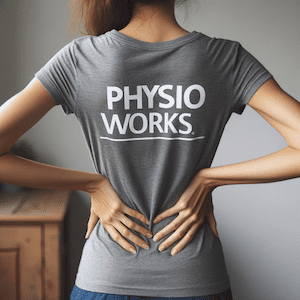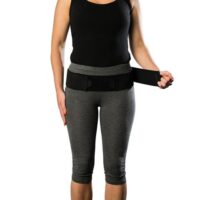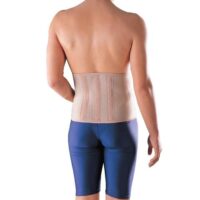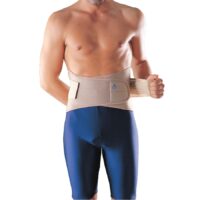Sacroiliac Joint (SIJ)
Article by John Miller

Sacroiliac Joint Pain
A Physiotherapist’s Guide to Relief
Harnessing Professional Advice to Manage SIJ Pain
Sacroiliac joint (SIJ) pain can disrupt your life significantly. This discomfort originates from the SIJ, a key junction where your lower spine and pelvis meet. It’s often due to trauma, muscle weakness, or abnormal mobility. As physiotherapists, we understand the importance of addressing the root causes of SIJ dysfunction, which can include either stiffness or excessive movement, leading to pain.
Combatting SIJ Pain
To tackle SIJ pain effectively, it’s crucial to strengthen the muscles around the joint, enhance posture, and relieve joint stress. Through stretching and physiotherapy, you can improve mobility and reduce discomfort. In certain cases, medications or injections might be required to manage pain and inflammation.
Understanding the Causes
Sacroiliac joint pain typically arises from two dysfunctions: hypermobility and hypomobility.
Factors Behind SIJ Hypermobility
Weak core and gluteal muscles often lead to SIJ hypermobility and resulting pain. Hypermobility, or excessive movement, can result from weak core muscles, gluteal and hip rotators weakness, pelvic floor weakness or trauma. Hormonal changes can also contribute. If you suspect hypermobility, seeking an SIJ physiotherapist’s advice is vital.
Dealing with SIJ Hypomobility
Hypomobility, or stiffness, often stems from inflammatory conditions, like Ankylosing Spondylitis, and structural abnormalities. Experiencing such stiffness necessitates a healthcare professional’s diagnosis for an appropriate treatment strategy. Identifying the exact cause is essential for effective treatment.

Recognising SIJ Pain Symptoms
SIJ pain can mimic other back and hip issues. It manifests as discomfort in the lower back, hip, groin, or buttocks, with certain activities triggering the pain. In women, symptoms might worsen during menstruation or sexual activities.
Diagnosing SIJ Pain
Diagnosing SIJ pain needs careful evaluation due to its resemblance to other back conditions. Although imaging tests like X-rays and MRI can help, a physical examination by a skilled SIJ physiotherapist often provides the most accurate assessment.
Recent Research Insights
Recent studies underscore the effectiveness of a multidisciplinary approach in treating SIJ pain. These include manual therapy, supervised exercise programs, and patient education about joint mechanics and self-management strategies. Research also highlights the importance of early intervention to prevent chronic pain development, emphasising the role of physiotherapists in early diagnosis and treatment planning. This approach aligns with the current understanding that SIJ pain is often multifactorial, requiring a comprehensive treatment strategy tailored to the individual’s needs.
Effective Treatment Approaches
A well-crafted treatment plan involves strengthening muscles supporting the joint and realigning the SIJ through targeted exercises. Your SIJ physiotherapist can assess and guide effective treatments. Initially, an SIJ stability belt may offer relief until muscles are strengthened adequately.

The Role of Exercise
Customised exercise programs can significantly alleviate SIJ pain. It’s essential to have these exercises assessed and prescribed by a SIJ physiotherapist to ensure they suit your specific condition.
Lifestyle Adjustments
In addition to exercise, lifestyle changes like weight management and avoiding certain postures can reduce SIJ pain. These adjustments aim to lessen strain and promote symmetrical joint alignment.
Recovery Time Expectations
Recovery duration for SIJ pain varies. Immediate relief is possible with proper joint realignment, but sustained improvement relies on consistent muscle strengthening as advised by a physiotherapist.
Conclusion: Seeking Professional Advice
There are multiple treatment options for sacroiliac joint pain, from tailored exercise regimens to muscle strengthening programs. Consulting a qualified SIJ physiotherapist is crucial for a customised approach to your condition. Don’t hesitate to seek professional support to enhance your well-being and quality of life.
Related Articles
- Common Causes of SIJ & Buttock Pain: Provides information on various conditions leading to buttock pain and SIJ issues, discussing joint injuries, muscle-related, nerve-related, and bone-related concerns.
- What is the Best Treatment for SIJ & Buttock Pain?: This article gives insights into different treatment approaches for SIJ and buttock pain, including physiotherapy strategies and supportive devices like SIJ belts.
- Greater Trochanteric Pain Syndrome (GTPS): Explores the connection between hip pain, including GTPS, and SIJ issues. It covers various FAQs about hip-related conditions and their treatments.
- Pregnancy Back Pain: Discusses back pain during pregnancy, particularly focusing on the SIJ and lumbar spine, providing insights for expectant mothers experiencing similar symptoms.
- Piriformis Syndrome: Elaborates on a condition where the piriformis muscle causes pain, often linked with SIJ dysfunction.
- Gluteal Tendinopathy: These articles discusses into conditions related to the hip and buttocks area, which can be relevant to those experiencing SIJ pain.
- Trochanteric Bursitis: Discusses another condition related to the hip area, often causing pain and discomfort that can be mistaken for SIJ issues.
- Sciatica: Provides information on sciatica, a condition often confused with SIJ pain due to the similarity in symptoms.
- Hip Core Dysfunction: Focuses on the importance of hip core strength, relevant to managing SIJ pain.




















